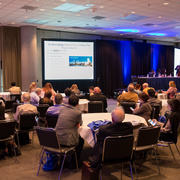
Choose a channel
Check out the different Progress in Mind content channels.

Progress in Mind





Of all specialist physicians, those working in psychiatry are the least likely to report being burned out, according to the 2016 Medscape Lifestyle Report.1 At 40%, psychiatrists are 3% more chilled even than dermatologists. Highest in the burnout stakes are critical care physicians, with 55%. Cardiologists come in at 50% and oncologists 46%.
Burnout was somewhat more common among female than male psychiatrists (43% vs 36%) but the proportion of burned out women in the profession has in fact been falling since 2013, when the figure stood at 62%. Among men, there has been a slight increase over the same period.
Data on the severity of burnout show a pattern similar to that for frequency. On a scale of 1 to 7, where 1 means that burnout does not interfere with my life, and 7 means so burned out I’m thinking of quitting medicine, psychiatrists averaged 3.9, level with rheumatologists at the bottom of the table. Critical care doctors were again top of the league, with 4.7.
The top cause of burnout reported by psychiatrists – by a substantial margin – was too many bureaucratic tasks (rated 4.3 on a scale of 1-7, where 1 equals does not contribute at all, and 7 equals significantly contributes). A cluster of factors tied for second place: inability to provide patients with the quality of care that they need, insufficient income, too many hours at work, maintenance of certification, and increased computerisation all had scores of 3.4.
Difficult colleagues, staff and employers were ranked as relatively unimportant reasons for burnout (scores of 2.6-2.7).
Burnout is an aspect of physicians’ personal lives that could have a profound effect on the quality of patient care. So too is bias.
Specialists were asked whether they thought they were biased in relation to certain groups of patients. Forty-eight percent of psychiatrists admitted that they were. This put them towards the head of a table topped by emergency medicine (62%). Unsurprisingly, bias in relation to patients was thought to be a factor by only 10% of pathologists.
However, while 48% of psychiatrists admitted experiencing bias, only 11% said that bias affected the way they treated a patient - and this may have been either a positive or negative effect.
Psychiatrists rated intelligence, followed by language differences, as the patient characteristics most likely to trigger bias. Race and gender were the least likely factors.
The likelihood of self-reported bias decreased with age, being cited by 67% of respondents under the age of 35 but only 38% of those aged 56 to 65. Psychiatrists who reported burnout were more likely than their non-burned out colleagues to report bias. The likelihood of bias was not related to presence or absence of spiritual belief or to liberal/conservative political allegiance.
One potential source of bias not asked about in the Medscape survey was comorbid substance abuse. This important topic was the focus of a presentation at the 2015 meeting of the American Academy of Addiction Psychiatry.2
Bernadine Han (Weill Cornell Medical College, New York) reported that psychiatry residents had more negative attitudes towards patients with substance use disorder in addition to mental health problems than towards patients with schizophrenia or depression alone. The extent of this negativity increases over the course of training.
According to the Medscape survey, psychiatrists are among the happiest physician specialties outside work: 63% said they were extremely or very happy. This was also true of happiness at work (37% rating themselves as extremely or very happy). In both settings, male psychiatrists were more likely to be happy than their female counterparts.
Of all specialists, psychiatrists were the least likely to exercise twice a week (43%). Those most likely to exercise regularly were dermatologists (72%). Paradoxically, though, psychiatrists were among the specialists least likely to be overweight. Excessive weight was admitted to by 35% of psychiatrists compared to 51% of pulmonary physicians.
Over 15,800 physicians (representing 25 specialties) responded to the survey.
Compared against other specialist physicians, psychiatrists are less likely to suffer burnout but more likely to admit to bias towards or against certain groups of patients.





SD, unlike loneliness, is an objective term to describe social isolation, Junghee Lee, UCLA, Los Angeles, USA, explained. It is prevalent in schizophrenia and is important because it affects survival direly – and to a greater extent than smoking. Unlike loneliness, you can die from SD.
Both social cognition and affiliation are affected in psychosis. This makes its study difficult. After all, how to you recruit socially-reclusive people to a clinical study?
By advertising, it would appear! Two small adverts were posted requesting people with few friends and no real inclination to make friends to respond. And respond they did – 66 calls over 3 days. By a sifting process, the general population was enriched for 28 individuals who were engaged in the community (i.e. they worked) but were socially isolated.
Unlike patients with schizophrenia, however, such individuals showed no evidence of social cognition deficits. They did show low levels of social affiliation. It seems, in the community, there are people who naturally avoid social situations. Intriguingly, their curiosity as to why this might be was what induced them to answer the ads.
Melissa Selb, of the WHO ICF Research Branch, Germany,, explained how, as part of its drive for health for all, the WHO has changed tack. Now instead of compiling only mortality and morbidity (ICD) statistics, it is collating the associated functioning and disability (ICF) that accompanies a condition.
Functioning and disability refer to a person’s:
Participation – e.g supported work programme
Activities e.g ability to wash oneself
Body function e.g thought function
Body structure e.g brain function
Environmental interactions e.g medication, family
Aspects of each of these were taken into consideration when creating the ICD-11 report with specific reference to schizophrenia. In total, 1400 ICF categories were described. As these are cumbersome to use, ICF core sets and brief core sets have been developed, making the classification system more user-friendly.
The ICF core sets were developed in 3 phases: a preparatory phase, phase I and phase II. Currently, the guidelines are in Phase II of development but the other phases were outlined.
Georgina Guilera, University of Barcelona, Spain, described the initial preparatory phase of the WHO project. Here the functional and environmental factors associated with schizophrenia were considered from 4 perspectives – clinical, research, patient and health care professional.
To address the clinical perspective, an empiric, multicentre study was conducted. Five Spanish centres contributed to this study and data were collected by health care professionals using the extended WHO checklist. Their responses were extracted and translated into ICF categories. ICF categories described functional impairment in body function (32), activities and participation (45) and environment (18).
A systematic literature review was undertaken to address the research perspective. A total of 206 studies identified ICF categories. These described functional impairment in body function (30), body structure (2) activities and participation (34) and environment (4).
The mortality associated with social disconnectedness in schizophrenia is greater than for smoking
For the patients’ perspective, a qualitative study was undertaken comprising 11 focus groups (7 for patients and 4 for caregivers) in Spain and US. The outcomes yielded ICF categories for body function (45), body structure (6) activities and participation (60) and environment (38).
Overall, the preparatory phase identified 184 candidate categories – clearly far too many for daily use. Oscar Pino, University of Barcelona, described how these were whittled down to generate comprehensive ICF core sets and brief core sets.
International experts in schizophrenia from a variety of fields were invited to consider the candidate categories and to achieve consensus on the minimum that should be included. This minimum number should describe exhaustively the key functional disabilities of those with schizophrenia. If consensus was less than 40%, categories were excluded; if consensus was greater than 75%, they were kept. Those falling between these values were discussed in a second session to attain consensus.
Eventually, a comprehensive ICF core set was achieved containing 97 ICF categories: body function (17), body structure (0) activities and participation (48) and environment (32). Following further discussion and some serious ranking, a brief core set of 25 ICF categories was agreed.
Now that all this work has been completed, validation of the categories generated in phase I is being undertaken. Outcomes are awaited with interest.
Poor functioning is an acknowledged hallmark of schizophrenia.

